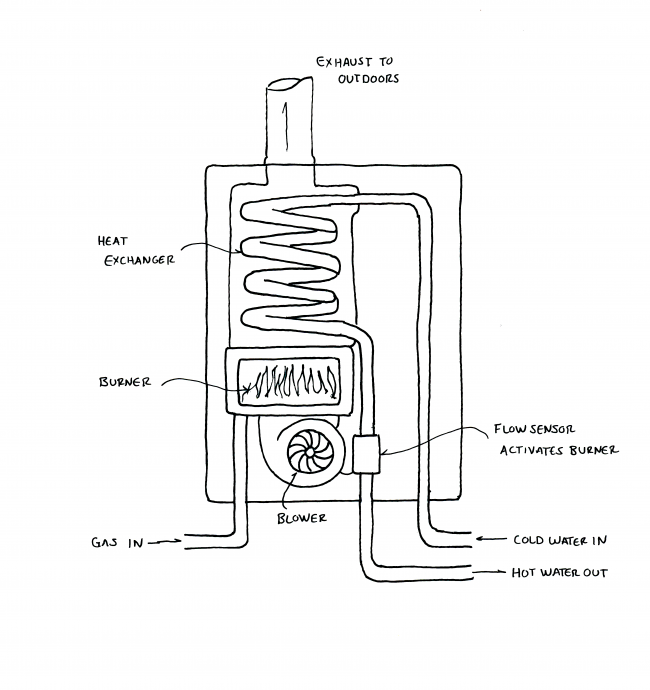Tankless or on demand heaters
HVAC: MATERIALS ENCYCLOPEDIA
Heat production & delivery
Fossil fuel heat production (gas- and oil-fired)
Electric resistance heat production
Hydronic heat delivery (can supply an air delivery system)
Can be used for domestic hot water heating
System components
Combustion chamber (or resistance elements for electric units)
Exhaust chimney (not required for electric units)
Heat exchanger
Direct vent (sealed) intake and exhaust (for combustion units)
Circulation pump
Temperature and pressure relief valve, expansion tank, air bleeder and balance of system as required
Controls as required
How the system works
 Tankless or on-demand heaters are very similar to direct heat boilers. The difference is in the design of the heat exchanger, which can heat a relatively small amount of water quickly. This can provide benefits for the production of domestic hot water, but is of dubious value for space heating systems.
Tankless or on-demand heaters are very similar to direct heat boilers. The difference is in the design of the heat exchanger, which can heat a relatively small amount of water quickly. This can provide benefits for the production of domestic hot water, but is of dubious value for space heating systems.
A flow detector triggers the heater when water begins to move in the supply pipe. Advanced models also sense the temperature of incoming water and modulate the amount of heat accordingly.
System output
Residential tankless heaters have outputs that range from 10,000–300,000 Btu/hr. Efficiency rates for condensing boilers range from 90–98 percent, with many units at 95–96 percent. Electric units are 100-percent efficient.
In most cases, the expressed efficiency is not the “true” thermal efficiency, which could be measured at an ideal steady state and not reflect real world performance. The accepted standard of efficiency is “annual fuel utilization efficiency” (AFUE). The method for determining the AFUE for residential furnaces is the subject of ASHRAE Standard 103. Ensure that rated output for comparison between units is the AFUE.
Environmental impacts: high
The impacts for tankless heaters are directly linked to the fuel source used to produce the heat. When considering the impacts of a fuel source, it is important to be as thorough as possible. Calculations for impacts must consider the entire life cycle, from extraction to processing, transportation, combustion and by-products. Effects on habitat, social fabric, geopolitical and financial systems and resilience must be taken into account along with more easily quantifiable (though likely controversial) numerical assessments such as carbon contributions and air pollutants (see Ranking Fuel Sources sidebar).
Material costs: Moderate
Unit type and output will affect cost.
Labor input: moderate
Skill level required for the homeowner
Installation — Difficult. Most boiler installations require a qualified professional.
Use — Easy.
Maintenance — Easy to Moderate. Annual inspection of burner flame (if required).
Sourcing/availability: Easy
There are sufficient numbers of tankless system designers, suppliers and installers that competitive quotes should be available in most regions.
Code compliance
Tankless systems are an accepted solution in all codes.
Durability: moderate
Tankless heaters are relatively new to the North American market, but are expected to last fifteen to thirty years, depending on use and maintenance. Manufacturers offer warranties of five to ten years on heat exchangers.
Indoor air quality
All combustion devices can create IAQ issues, as they consume air and produce exhaust. Modern, code-approved devices have “sealed” combustion, meaning that combustion air is drawn directly from outside and exhausted back to the outside, and usually drawn by a fan to ensure proper flow. There are many possible points of leakage in these systems; be sure to check installations for issues. The combustion chamber is never completely sealed from indoors, and some amount of indoor air will be drawn into the unit.
Hydronic delivery systems result in gentle air movement and minimal circulation of dust and allergens.
Forced-air delivery systems can circulate a lot of dust and allergens. Use the best filters possible to help reduce issues.
Adequate ventilation is required in any well-sealed home. Whether provided actively or passively, ensure that pre-warmed fresh air is introduced and circulated in the home during seasons when windows are closed.
Future development
Efficiency levels for condensing tankless heater are approaching 100 percent, beyond which there is no further improvement. Refinement of controls and pumps will likely lead to small gains for entire systems.
A possible avenue for improvement is the incorporation of solar thermal heating systems that work in conjunction with tankless heaters, resulting in systems that seamlessly use the least amount of non-solar energy possible.
Resilience
Some tankless heaters can be operated in a low-energy scenario, but entire systems are very difficult to build and install without hi-tech components.
Tips for a successful tankless or on-demand heater
1. Many boilers have output capacities and temperatures that far exceed the needs of an energy-efficient home. Be sure to choose a unit that matches your heat loss calculation and required temperature closely.
2. Units with stainless steel or aluminum/silicon alloy heat exchangers can be a worthwhile investment, inhibiting corrosion of vulnerable components.
3. Boilers are proprietary units and each will have unique installation instructions that should be followed.



